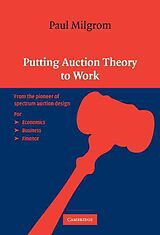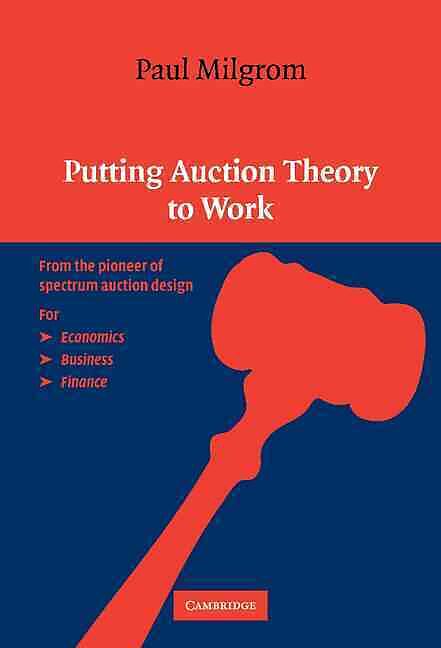Putting Auction Theory to Work
Einband:
Fester Einband
EAN:
9780521551847
Untertitel:
Englisch
Genre:
Allgemeines & Lexika
Autor:
Paul Milgrom
Herausgeber:
Cambridge University Press
Anzahl Seiten:
394
Erscheinungsdatum:
07.01.2015
ISBN:
0521551846
Klappentext Providing a comprehensive introduction to modern auction theory and its important new applications! this book is written by a leading economic theorist whose suggestions guided the creation of the new spectrum auction designs. Aimed at graduate students and professionals in economics! the volume provides the most up-to-date analysis of traditional theories of "optimal auctions" as well as newer theories of multi-unit auctions and package auctions! and shows by example how these theories are used. It explores the limitations of prominent older designs! such as the Vickrey auction design! and evaluates the practical responses to those limitations. Paul Milgrom is the Leonard and Shirley Ely Professor of Humanities and Sciences and Professor of Economics! Stanford University. He is the author of more than sixty articles and co-author of the influential textbook! Economics! Organization and Management (Prentice Hall! 1992). Professor Milgrom is a pioneer in the economic theory of auctions and co-designer of the simultaneous! multiple round auction that the FCC adopted for selling radio spectrum licenses. Visit the author's website for instructor resources. Zusammenfassung A comprehensive introduction to modern auction theory and its applications. Aimed at graduate students and professionals in economics! the book gives the most up-to-date treatments of both traditional theories of 'optimal auctions' and newer theories of multi-unit auctions and package auctions! and shows by example how these theories are used. Inhaltsverzeichnis Section 1. Getting to Work: 1. Politics sets the stage; 2. Designing for multiple goals; 3. Comparing seller revenues; 4. The academic critics; 5. Plan for this book; Part I. The Mechanism Design Approach; Section 2. Vickrey Clarke Groves Mechanisms: 6. Formulation; 7. Always optimal and weakly dominant strategies; 8. Balancing the budget; 9. Uniqueness; 10. Disadvantages of the Vickrey auction; 11. Conclusion; Section 3. The Envelope Theorem and Payoff Equivalence: 12. Hottelling's lemma; 13. The envelope theorem in integral form; 14. Quasi-linear payoffs; 15. Conclusion; Section 4. Bidding Equilibrium and Revenue Differences: 16. The single crossing conditions; 17. Deriving and verifying equilibrium strategies; 18. Revenue comparisons in the benchmark model; 19. Expected-revenue maximizing auctions; 20. Conclusion; Section 5. Interdependence of Types and Values: 21. Which models and assumptions are 'useful'?; 22. Statistical dependence and revenue-maximizing auctions; 23. Wilson's drainage tract model; 24. Correlated types model interdependent values; 25. Conclusion; Section 6. Auctions in Context: 26. The profit and surplus contribution of an entrant; 27. Symmetric models with costly entry; 28. Asymmetric models: devices to promote competition; 29. After the bidding ends; 30. Conclusion; Part II. Multi-Unit Auctions; Section 7. Uniform Price Auctions: 31. Uniform price sealed bid auctions; 32. Simultaneous ascending auctions; 33. Conclusion; Section 8. Package Auctions and Combinatorial Bidding: 34. Vickrey auctions and the monotonicity problems; 35. Bernheim Whinston first-price package auctions; 36. Ausubel Milgrom ascending proxy auctions; 37. Conclusion....
Zusammenfassung
A comprehensive introduction to modern auction theory and its applications. Aimed at graduate students and professionals in economics, the book gives the most up-to-date treatments of both traditional theories of 'optimal auctions' and newer theories of multi-unit auctions and package auctions, and shows by example how these theories are used.
Inhalt
Section 1. Getting to Work: 1. Politics sets the stage; 2. Designing for multiple goals; 3. Comparing seller revenues; 4. The academic critics; 5. Plan for this book; Part I. The Mechanism Design Approach; Section 2. Vickrey Clarke Groves Mechanisms: 6. Formulation; 7. Always optimal and weakly dominant strategies; 8. Balancing the budget; 9. Uniqueness; 10. Disadvantages of the Vickrey auction; 11. Conclusion; Section 3. The Envelope Theorem and Payoff Equivalence: 12. Hottelling's lemma; 13. The envelope theorem in integral form; 14. Quasi-linear payoffs; 15. Conclusion; Section 4. Bidding Equilibrium and Revenue Differences: 16. The single crossing conditions; 17. Deriving and verifying equilibrium strategies; 18. Revenue comparisons in the benchmark model; 19. Expected-revenue maximizing auctions; 20. Conclusion; Section 5. Interdependence of Types and Values: 21. Which models and assumptions are 'useful'?; 22. Statistical dependence and revenue-maximizing auctions; 23. Wilson's drainage tract model; 24. Correlated types model interdependent values; 25. Conclusion; Section 6. Auctions in Context: 26. The profit and surplus contribution of an entrant; 27. Symmetric models with costly entry; 28. Asymmetric models: devices to promote competition; 29. After the bidding ends; 30. Conclusion; Part II. Multi-Unit Auctions; Section 7. Uniform Price Auctions: 31. Uniform price sealed bid auctions; 32. Simultaneous ascending auctions; 33. Conclusion; Section 8. Package Auctions and Combinatorial Bidding: 34. Vickrey auctions and the monotonicity problems; 35. Bernheim Whinston first-price package auctions; 36. Ausubel Milgrom ascending proxy auctions; 37. Conclusion.

Leider konnten wir für diesen Artikel keine Preise ermitteln ...
billigbuch.ch sucht jetzt für Sie die besten Angebote ...
Die aktuellen Verkaufspreise von 6 Onlineshops werden in Realtime abgefragt.
Sie können das gewünschte Produkt anschliessend direkt beim Anbieter Ihrer Wahl bestellen.
Loading...
Die aktuellen Verkaufspreise von 6 Onlineshops werden in Realtime abgefragt.
Sie können das gewünschte Produkt anschliessend direkt beim Anbieter Ihrer Wahl bestellen.
| # | Onlineshop | Preis CHF | Versand CHF | Total CHF | ||
|---|---|---|---|---|---|---|
| 1 | Seller | 0.00 | 0.00 | 0.00 |
